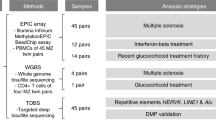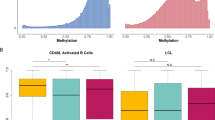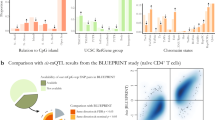Abstract
Multiple lines of evidence indicate Multiple Sclerosis (MS) is affected by vitamin D. This effect may be mediated by methylation in immune cell progenitors. We aimed to determine (1) if haematopoietic stem cell methylation constrains methylation in daughter cells and is variable between individuals, and (2) the interaction of methylation with the vitamin D receptor binding sites. We interrogated genomic methylation levels from matching purified CD34+ haematopoietic stem cells and progeny CD14+ monocytes and CD56+ NK cells from 11 individuals using modified reduced representation bisulfite sequencing. Differential methylation of Vitamin D Receptor binding sites and MS risk genes was assessed from this and using pyrosequencing for the vitamin D regulated MS risk gene ZMIZ1. Although DNA methylation states at CpG islands and other sites are almost entirely recapitulated between progenitor and progeny immune cells, significant variation was detected at some regions between cell subsets and individuals; including around the MS risk genes HLA DRB1 and the vitamin D repressor NCOR2. Methylation of the vitamin D responsive MS risk gene ZMIZ1 was associated with risk SNP and disease. We conclude that DNA methylation settings in adult haematopoietic stem cells may contribute to individual variation in vitamin D responses in immune cells.
This is a preview of subscription content, access via your institution
Access options
Subscribe to this journal
Receive 6 digital issues and online access to articles
$119.00 per year
only $19.83 per issue
Buy this article
- Purchase on Springer Link
- Instant access to full article PDF
Prices may be subject to local taxes which are calculated during checkout






Similar content being viewed by others
Data availability
The datasets supporting the conclusions of this article are available in the GEO database under the accession number GSE114254.
References
Wacker M, Holick MF. Sunlight and Vitamin D: a global perspective for health. Derm-Endocrinol. 2013;5:51–108.
Miller D, Hammond S, McLeod J, Purdie G, Skegg D. Multiple sclerosis in Australia and New Zealand: are the determinants genetic or environmental? J Neurol, Neurosurg Psychiatry. 1990;53:903–5.
Dankers W, Colin EM, van Hamburg JP, Lubberts E. Vitamin D in autoimmunity: molecular mechanisms and therapeutic potential. Front Immunol. 2017;7:697.
McLaughlin L, Clarke L, Khalilidehkordi E, Butzkueven H, Taylor B, Broadley SA. Vitamin D for the treatment of multiple sclerosis: a meta-analysis. J Neurol. 2018;265:2893–905.
Zheng C, He L, Liu L, Zhu J, Jin T. The efficacy of vitamin D in multiple sclerosis: a meta-analysis. Mult Scler Relat Disord. 2018;23:56–61.
International Multiple Sclerosis Genetics Consortium. Low-Frequency and Rare-Coding Variation Contributes to Multiple Sclerosis Risk. Cell. 2018;175:1679–87. e7.
Beecham AH. IMSGC. Analysis of immune-related loci identifies 48 new susceptibility variants for multiple sclerosis. Nat Genet. 2013;45:1353–60.
International Multiple Sclerosis Genetics C, Wellcome Trust Case Control C, Sawcer S, Hellenthal G, Pirinen M, Spencer CC, et al. Genetic risk and a primary role for cell-mediated immune mechanisms in multiple sclerosis. Nature. 2011;476:214–9.
Consortium IMSG. Multiple sclerosis genomic map implicates peripheral immune cells and microglia in susceptibility. Science. 2019;365:eaav7188.
Shahijanian F, Parnell GP, McKay FC, Gatt PN, Shojoei M, O’connor KS, et al. The CYP27B1 variant associated with an increased risk of autoimmune disease is underexpressed in tolerizing dendritic cells. Hum Mol Genet. 2013;23:1425–34.
Booth D, Ding N, Parnell G, Shahijanian F, Coulter S, Schibeci S, et al. Cistromic and genetic evidence that the vitamin D receptor mediates susceptibility to latitude-dependent autoimmune diseases. Genes Immun. 2016;17:213.
Parnell GP, Schibeci SD, Fewings NL, Afrasiabi A, Law SP, Samaranayake S, et al. The latitude-dependent autoimmune disease risk genes ZMIZ1 and IRF8 regulate mononuclear phagocytic cell differentiation in response to vitamin D. Hum Mol Genet. 2018;28:269–78.
Fewings NL, McKay FC, Parnell GP, Schibeci SD, Edwards J, Basuki MA, et al. The autoimmune risk gene ZMIZ1 is a vitamin D responsive marker of a molecular phenotype of multiple sclerosis. J Autoimmun. 2017;78:57–69.
Gaunt TR, Shihab HA, Hemani G, Min JL, Woodward G, Lyttleton O, et al. Systematic identification of genetic influences on methylation across the human life course. Genom Biol. 2016;17:61.
Orru V, Steri M, Sole G, Sidore C, Virdis F, Dei M, et al. Genetic variants regulating immune cell levels in health and disease. Cell. 2013;155:242–56.
Brodin P, Jojic V, Gao T, Bhattacharya S, Angel CJ, Furman D, et al. Variation in the human immune system is largely driven by non-heritable influences. Cell. 2015;160:37–47.
Roederer M, Quaye L, Mangino M, Beddall MH, Mahnke Y, Chattopadhyay P, et al. The genetic architecture of the human immune system: a bioresource for autoimmunity and disease pathogenesis. Cell. 2015;161:387–403.
Scheid AD, Van Keulen VP, Felts SJ, Neier SC, Middha S, Nair AA, et al. Gene expression signatures characterized by longitudinal stability and interindividual variability delineate baseline phenotypic groups with distinct responses to immune stimulation. J Immunol. 2018;200:1917–28.
Carlberg C. Molecular endocrinology of vitamin D on the epigenome level. Mol Cell Endocrinol. 2017;453:14–21.
Guo H, Zhu P, Yan L, Li R, Hu B, Lian Y, et al. The DNA methylation landscape of human early embryos. Nature. 2014;511:606–10.
Jones MJ, Goodman SJ, Kobor MS. DNA methylation and healthy human aging. Aging Cell. 2015;14:924–32.
Bell JT, Pai AA, Pickrell JK, Gaffney DJ, Pique-Regi R, Degner JF, et al. DNA methylation patterns associate with genetic and gene expression variation in HapMap cell lines. Genome Biol. 2011;12:R10.
Bock C, Paulsen M, Tierling S, Mikeska T, Lengauer T, Walter J. CpG island methylation in human lymphocytes is highly correlated with DNA sequence, repeats, and predicted DNA structure. PLoS Genet. 2006;2:e26.
Takeyama K-i, Kato S. The vitamin D3 1alpha-hydroxylase gene and its regulation by active vitamin D3. Biosci, Biotechnol, Biochem. 2011;75:208–13.
Wang M, Kong W, He B, Li Z, Song H, Shi P, et al. Vitamin D and the promoter methylation of its metabolic pathway genes in association with the risk and prognosis of tuberculosis. Clin Epigenet. 2018;10:118.
Moore JR, Hubler SL, Nelson CD, Nashold FE, Spanier JA, Hayes CE. 1,25-Dihydroxyvitamin D3 increases the methionine cycle, CD4(+) T cell DNA methylation and Helios(+)Foxp3(+) T regulatory cells to reverse autoimmune neurodegenerative disease. J Neuroimmunol. 2018;324:100–14.
Olsson T, Barcellos LF, Alfredsson L. Interactions between genetic, lifestyle and environmental risk factors for multiple sclerosis. Nat Rev Neurol. 2017;13:25.
Ng RL, Scott NM, Strickland DH, Gorman S, Grimbaldeston MA, Norval M, et al. Altered immunity and dendritic cell activity in the periphery of mice after long-term engraftment with bone marrow from ultraviolet-irradiated mice. J Immunol. 2013:190;1202786.
Lipka DB, Wang Q, Cabezas-Wallscheid N, Klimmeck D, Weichenhan D, Herrmann C, et al. Identification of DNA methylation changes at cis-regulatory elements during early steps of HSC differentiation using tagmentation-based whole genome bisulfite sequencing. Cell Cycle. 2014;13:3476–87.
Farlik M, Halbritter F, Muller F, Choudry FA, Ebert P, Klughammer J, et al. DNA Methylation Dynamics of Human Hematopoietic Stem Cell Differentiation. Cell Stem Cell. 2016;19:808–22.
Ji H, Ehrlich LI, Seita J, Murakami P, Doi A, Lindau P, et al. Comprehensive methylome map of lineage commitment from haematopoietic progenitors. Nature. 2010;467:338–42.
Hodges E, Molaro A, Dos Santos CO, Thekkat P, Song Q, Uren PJ, et al. Directional DNA methylation changes and complex intermediate states accompany lineage specificity in the adult hematopoietic compartment. Mol Cell. 2011;44:17–28.
Bock C, Beerman I, Lien WH, Smith ZD, Gu H, Boyle P, et al. DNA methylation dynamics during in vivo differentiation of blood and skin stem cells. Mol Cell. 2012;47:633–47.
Andrews S. FastQC: A Quality Control Tool for High Throughput Sequence Data [Online]. Available online at: http://www.bioinformatics.babraham.ac.uk/projects/fastqc/. 2010.
Bolger AM, Lohse M, Usadel B. Trimmomatic: a flexible trimmer for Illumina sequence data. Bioinformatics. 2014;30:2114–20.
Song Q, Decato B, Hong EE, Zhou M, Fang F, Qu J, et al. A reference methylome database and analysis pipeline to facilitate integrative and comparative epigenomics. PLoS ONE. 2013;8:e81148.
Zerbino DR, Wilder SP, Johnson N, Juettemann T, Flicek PR. The ensembl regulatory build. Genome Biol. 2015;16:56.
Simon R, Lam A, Li M-C, Ngan M, Menenzes S, Zhao Y. Analysis of gene expression data using BRB-array tools. Cancer Inform. 2007;3:117693510700300022.
Curtis EM, Krstic N, Cook E, D’Angelo S, Crozier SR, Moon RJ, et al. Gestational Vitamin D Supplementation Leads to Reduced Perinatal RXRA DNA Methylation: Results From the MAVIDOS Trial. J Bone Miner Res. 2019;34:231–40.
Lowe R, Gemma C, Beyan H, Hawa MI, Bazeos A, Leslie RD, et al. Buccals are likely to be a more informative surrogate tissue than blood for epigenome-wide association studies. Epigenetics. 2013;8:445–54.
Chen L, Ge B, Casale FP, Vasquez L, Kwan T, Garrido-Martín D, et al. Genetic drivers of epigenetic and transcriptional variation in human immune cells. Cell. 2016;167:1398–414. e24.
Jones PA. Functions of DNA methylation: islands, start sites, gene bodies and beyond. Nat Rev Genet. 2012;13:484.
Su AI, Wiltshire T, Batalov S, Lapp H, Ching KA, Block D, et al. A gene atlas of the mouse and human protein-encoding transcriptomes. Proc Natl Acad Sci USA. 2004;101:6062–7.
Hogart A, Lichtenberg J, Ajay SS, Anderson S, Center NIHIS, Margulies EH, et al. Genome-wide DNA methylation profiles in hematopoietic stem and progenitor cells reveal overrepresentation of ETS transcription factor binding sites. Genome Res. 2012;22:1407–18.
Ji H, Ehrlich LI, Seita J, Murakami P, Doi A, Lindau P, et al. A comprehensive methylome map of lineage commitment from hematopoietic progenitors. Nature. 2010;467:338.
Valencia RAC, Martino DJ, Saffery R, Ellis JA. In vitro exposure of human blood mononuclear cells to active vitamin D does not induce substantial change to DNA methylation on a genome-scale. J Steroid Biochem Mol Biol. 2014;141:144–9.
Ramagopalan SV, Maugeri NJ, Handunnetthi L, Lincoln MR, Orton SM, Dyment DA, et al. Expression of the multiple sclerosis-associated MHC class II Allele HLA-DRB1*1501 is regulated by vitamin D. PLoS Genet. 2009;5:e1000369.
Graves MC, Benton M, Lea R, Boyle M, Tajouri L, Macartney-Coxson D, et al. Methylation differences at the HLA-DRB1 locus in CD4+ T-Cells are associated with multiple sclerosis. Mult Scler J. 2014;20:1033–41.
Maltby VE, Graves MC, Lea RA, Benton MC, Sanders KA, Tajouri L, et al. Genome-wide DNA methylation profiling of CD8+ T cells shows a distinct epigenetic signature to CD4+ T cells in multiple sclerosis patients. Clin Epigenet. 2015;7:118.
Maltby VE, Lea RA, Graves MC, Sanders KA, Benton MC, Tajouri L, et al. Genome-wide DNA methylation changes in CD19+ B cells from relapsing-remitting multiple sclerosis patients. Sci Rep. 2018;8:17418.
Rhead B, Brorson IS, Berge T, Adams C, Quach H, Moen SM, et al. Increased DNA methylation of SLFN12 in CD4+ and CD8+ T cells from multiple sclerosis patients. PloS ONE. 2018;13:e0206511.
Hannon E, Gorrie-Stone TJ, Smart MC, Burrage J, Hughes A, Bao Y, et al. Leveraging DNA-Methylation Quantitative-Trait Loci to Characterize the Relationship between Methylomic Variation, Gene Expression, and Complex Traits. Am J Hum Genet. 2018;103:654–65.
Krzywinski MI, Schein JE, Birol I, Connors J, Gascoyne R, Horsman D, et al. Circos: an information aesthetic for comparative genomics. Genome Res. 2009;19:1639–45.
Acknowledgements
The authors would like to thank Ellis Patrick for invaluable biostatistical advice, Nicole Fewings and Stephen Schibeci for assistance with practical aspects of this study and volunteers from the Westmead Institute for Medical Research who kindly donated samples for this project. Flow cytometry was performed at the Flow Cytometry Core Facility that is supported by Westmead Research Hub, Cancer Institute NSW and NHMRC. Bioinformatic analysis was supported by Sydney Informatics Hub, funded by the University of Sydney.
Funding
LO was supported by a National Health and Medical Research Council (NHMRC), Trish MS Foundation and MS Research Australia co-funded postgraduate scholarship. GP was supported by a MS Research Australia Postdoctoral Fellowship and a MS Research Australia/ JDRF Australia/ Macquarie Group Foundation Postdoctoral Fellowship. DB was supported by a NHMRC Senior Research Fellowship and MSRA Project Grant.
Author information
Authors and Affiliations
Contributions
LO, GP and DB planned the experiment, analysed the data and prepared the paper. LO conducted all genomic methylation experiments. KV analysed the ZMIZ1 pyrosequencing data. GS and CL assisted in preparation of the paper. All authors read and approved the final paper.
Corresponding author
Ethics declarations
Conflict of interest
The authors declare that they have no conflict of interest.
Ethical approval
This study received ethics approval from the Western Sydney Local Health District Human Research Ethics Committee (HREC2002/9/3.6(1425)).
Informed consent
Informed, written consent was obtained from subjects prior to involvement in this study.
Additional information
Publisher’s note Springer Nature remains neutral with regard to jurisdictional claims in published maps and institutional affiliations.
Rights and permissions
About this article
Cite this article
Ong, L.T.C., Parnell, G.P., Veale, K. et al. Regulation of the methylome in differentiation from adult stem cells may underpin vitamin D risk in MS. Genes Immun 21, 335–347 (2020). https://doi.org/10.1038/s41435-020-00114-4
Received:
Revised:
Accepted:
Published:
Issue Date:
DOI: https://doi.org/10.1038/s41435-020-00114-4
This article is cited by
-
ZMIZ proteins: partners in transcriptional regulation and risk factors for human disease
Journal of Molecular Medicine (2022)



